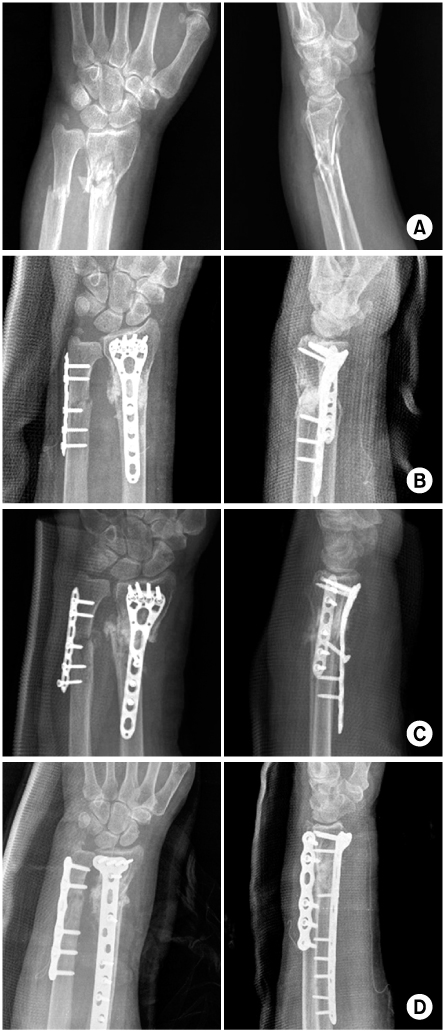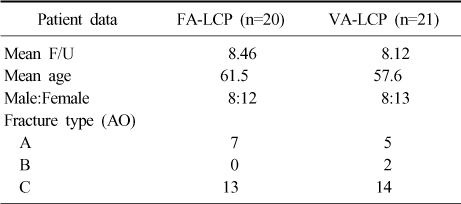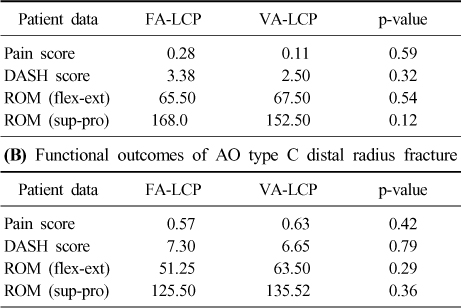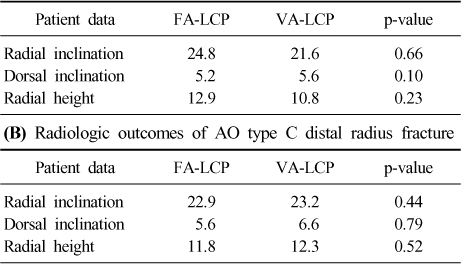Articles
- Page Path
- HOME > J Musculoskelet Trauma > Volume 25(3); 2012 > Article
-
Original Article
- Comparative Analysis of the Results of Fixed-angle versus Variable-angle Volar Locking Plate for Distal Radius Fracture Fixation
- Seung-Do Cha, M.D., Jai-Hyung Park, M.D., Hyung-Soo Kim, M.D., Soo-Tae Chung, M.D., Jeong-Hyun Yoo, M.D., Joo-Hak Kim, M.D., Jung-Hwan Park, M.D.
-
Journal of the Korean Fracture Society 2012;25(3):197-202.
DOI: https://doi.org/10.12671/jkfs.2012.25.3.197
Published online: July 16, 2012
Department of Orthopedic Surgery, Myong-Ji Hospital, Kwandong University College of Medicine, Goyang, Korea.
- Address reprint requests to: Joo-Hak Kim, M.D. Department of Orthopedic Surgery, Myung-Ji Hospital, Kwandong University College of Medicine, 55, Hwasu-ro 14beon-gil, Deogyang-gu, Goyang 412-270, Korea. Tel: 82-31-810-6531, Fax: 82-31-810-6537, hand0123@kd.ac.kr
Copyright © 2012 The Korean Fracture Society
- 514 Views
- 3 Download
- 3 Crossref
Figure & Data
REFERENCES
Citations

- Volar locking plate fixation for distal radius fractures: did variable-angle plates make difference?
Mohamed Abdel-Wahed, Ahmed Abdel-Zaher Khater, Mahmoud Ahmed El-Desouky
International Orthopaedics.2022; 46(9): 2165. CrossRef - Treatment of Fractures of the Distal Radius Using Variable-Angle Volar Locking Plate
Jae-Cheon Sim, Sung-Sik Ha, Ki-Do Hong, Tae-Ho Kim, Min-Chul Sung
Journal of the Korean Fracture Society.2015; 28(1): 46. CrossRef - Functional Outcomes of Percutaneous K-Wire Fixation for Distal Radius Fractures with or without Osteoporosis
Ki-Chan An, Gyu-Min Kong, Jang-Seok Choi, Hi-Chul Gwak, Joo-Yong Kim, Sung-Yub Jin
Journal of the Korean Fracture Society.2013; 26(4): 248. CrossRef

Fig. 1
Summary of cases
FA-LCP: Fixed-angle locking plate group, VA-LCP: Variable-angle locking plate group, F/U: follow-up.
(A) Functional outcomes of AO type A distal radius fracture
FA-LCP: Fixed-angle locking plate group, VA-LCP: Variable-angle locking plate group, DASH: Disabilities of the Arm, Shoulder and Hand Questionnaire, ROM: Range of motion, flex-ext: Flexion-extension, sup-pro: Supination-pronation.
Complications
FA-LCP: Fixed-angle locking plate group, VA-LCP: Variable-angle locking plate group.
(A) Radiologic outcomes of AO type A distal radius fracture
FA-LCP: Fixed-angle locking plate group, VA-LCP: Variable-angle locking plate group.
FA-LCP: Fixed-angle locking plate group, VA-LCP: Variable-angle locking plate group, F/U: follow-up.
FA-LCP: Fixed-angle locking plate group, VA-LCP: Variable-angle locking plate group, DASH: Disabilities of the Arm, Shoulder and Hand Questionnaire, ROM: Range of motion, flex-ext: Flexion-extension, sup-pro: Supination-pronation.
FA-LCP: Fixed-angle locking plate group, VA-LCP: Variable-angle locking plate group.
FA-LCP: Fixed-angle locking plate group, VA-LCP: Variable-angle locking plate group.

 E-submission
E-submission KOTA
KOTA TOTA
TOTA TOTS
TOTS





 Cite
Cite

